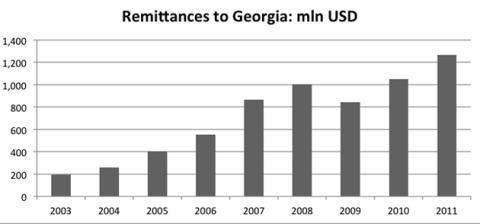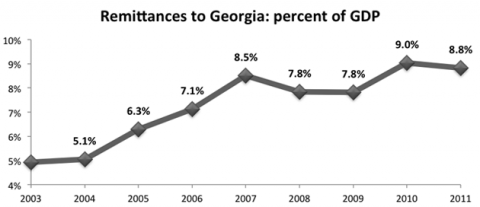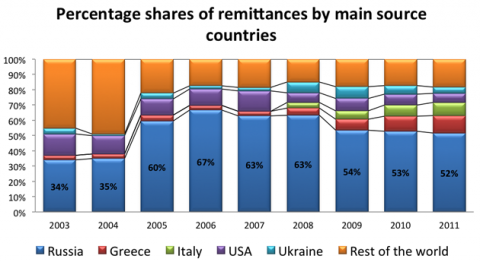 02
July
2024
02
July
2024
ISET Economist Blog
 Wednesday,
26
September,
2012
Wednesday,
26
September,
2012

 Wednesday,
26
September,
2012
Wednesday,
26
September,
2012
As any other labor-exporting country, Georgia faces both the costs and benefits of migration. The main costs include human capital flight – the so-called “brain drain” – and the distortion of the age and gender structure of the population.
The benefits include alleviating social pressures caused by high unemployment rates, the international experience and skills returning migrants bring back to their home countries, and, very importantly, the remittances, or money transfers, that emigrants make to their families. For many households in Georgia, these money transfers represent the only means of financing personal consumption expenditures, education, and health care.
Remittance inflows to Georgia are as important for the whole economy as they are for the recipient households. Growing steadily since 2003, in 2011 remittances amounted to almost $1.3 billion, which is about 8.8% of Georgia’s total GDP. In addition to this, as the bulk of remittance inflows are denominated in US dollars, they represent a major source of foreign exchange and thus are significant in financing Georgia’s trade deficit (i.e. remittances account for a larger share of trade deficits than FDI!). Moreover, these money transfers are a more stable source of foreign exchange than other types of foreign capital inflows, including FDI. Importantly for the stability of remittance inflows, Georgia’s “portfolio” of remitting countries is becoming more diversified over time. While still accounting for more than a half of total remittances to Georgia, Russia’s share is on a steady decline from the peak of 67% in 2006 to 52% in 2011.



There are two different motivations encouraging an emigrant to send money to his home country: altruism and investment. Altruistically motivated emigrants might send money to ease their family’s economic burden. Such individuals would be expected to send more money when their families find themselves in economic hardship. On the other hand, emigrants with investment interests might want to send money back to their families to do things such as deposit money in a local bank account or invest in real estate or a business on their behalf. In this instance, one may expect a greater amount of remittances at a time when investment opportunities in Georgia are more favorable compared to those in remittance-source countries. Of course, for many emigrants, the two motives might hold equal importance.
Both altruistic and investment motives shape Georgian emigrants’ behavior and affect their decisions to remit. On the one hand, they seek to compensate for relatively unfavorable economic conditions in Georgia and send more money when the real GDP growth gap between the remittance-source countries and Georgia widens. On the other hand, they tend to take advantage of favorable investment opportunities in Georgia, whenever they are available. Georgian emigrants transfer more money when the lari depreciates, taking advantage of the low price of domestic assets in terms of foreign currency. Likewise, when the lari appreciates remitters try to postpone their money transfers until a period when the lari has depreciated.
An implication of my findings is that remittances serve as a good automatic stabilizer of the exchange rate. In the event of a large depreciation of the lari (which, according to my study, stimulate remittances), an increase in remittance inflows may, to some extent, push the domestic currency back to its previous value by stimulating demand for it.
As long as Georgian emigrants keep being altruistic, as they seem to be now, or provided that investment motives continue to be important in their decisions, Georgia will continue enjoying large remittance inflows. This prediction is of course conditional on the number of Georgian emigrants abroad remaining at about the same level they do now.
This is likely to be the case until such a time as Georgia can create the jobs for its Western-educated and highly-skilled workers to come back. This, however, is yet a topic deserving more detailed analysis…





